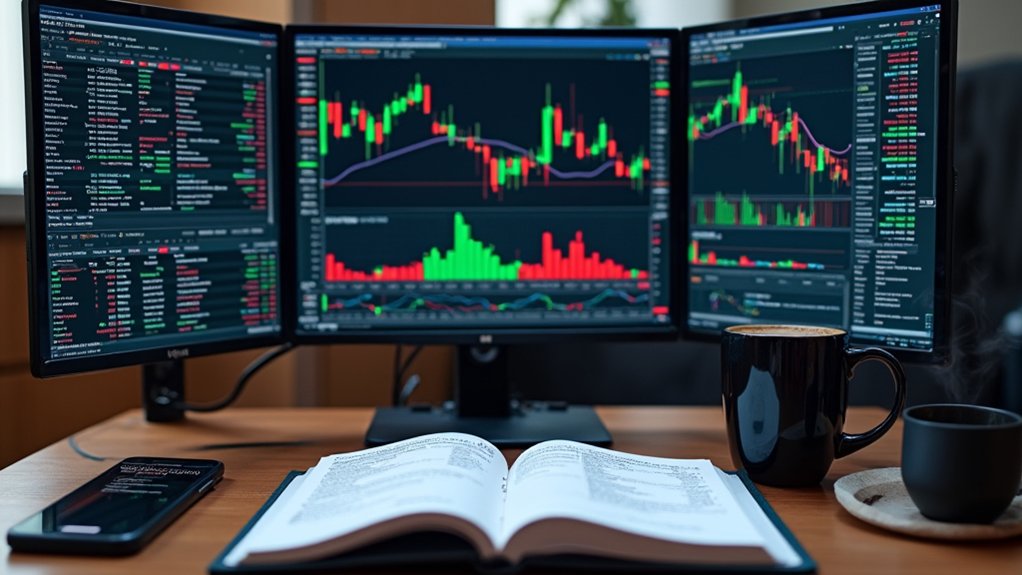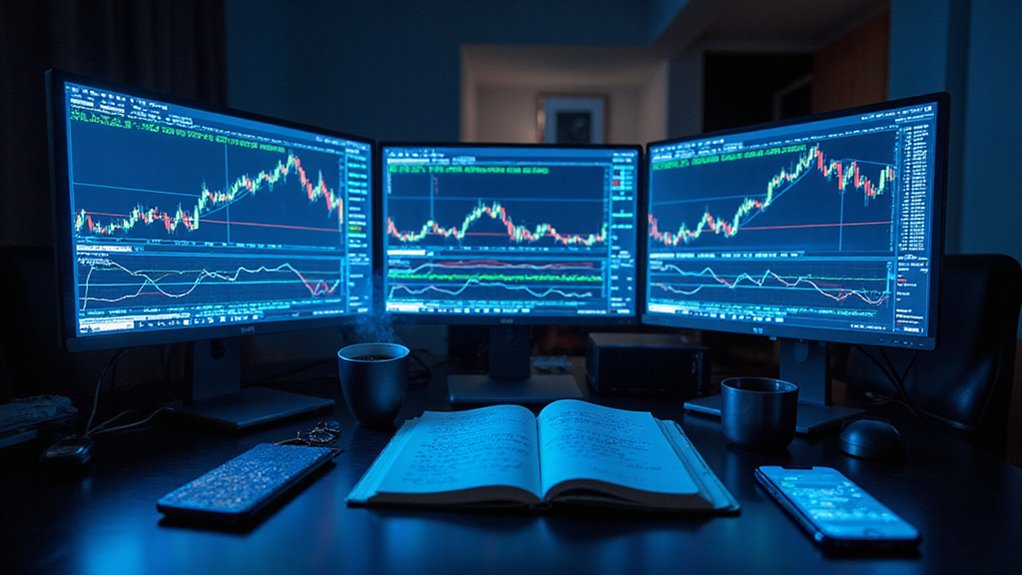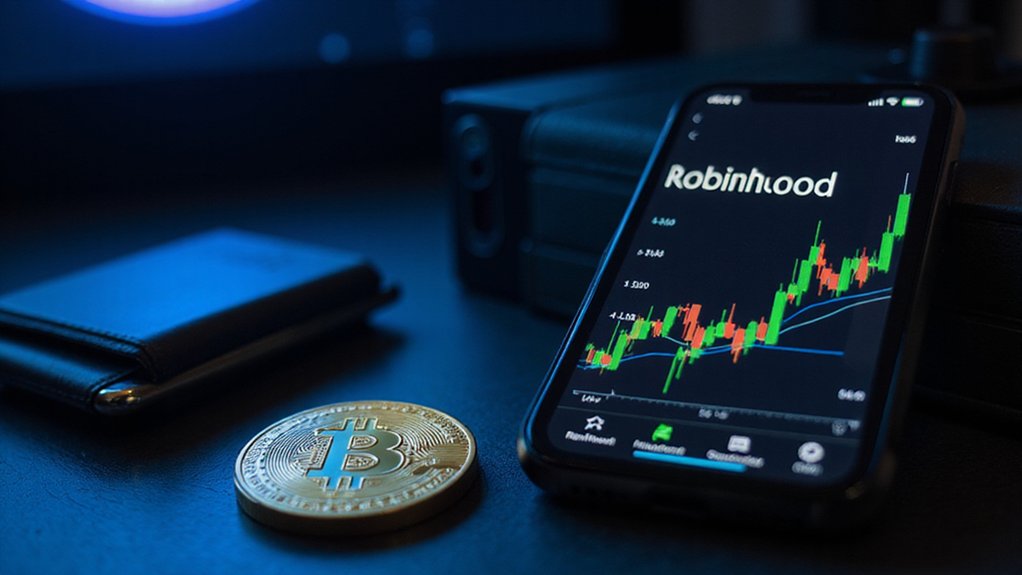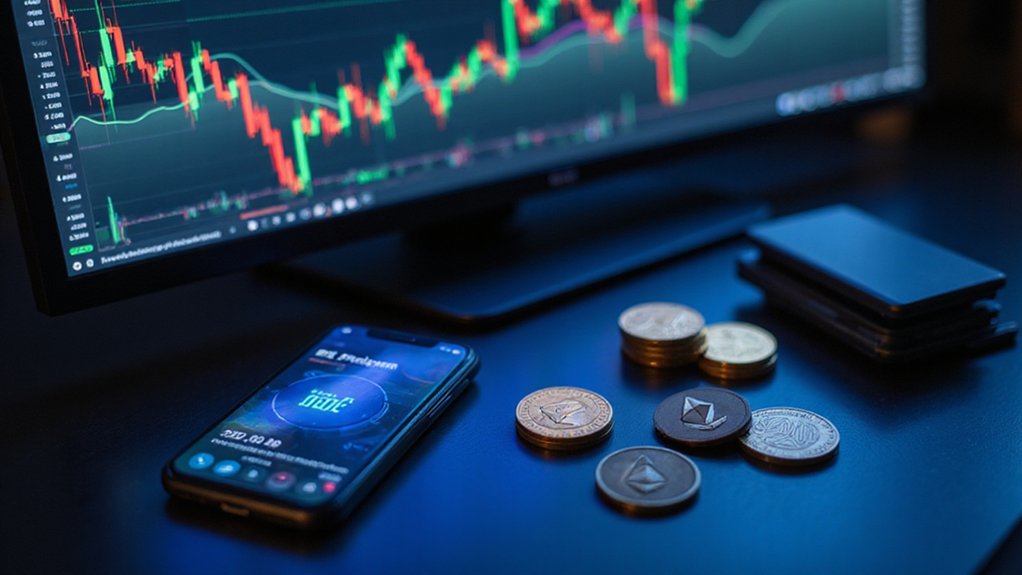Mastering cryptocurrency day trading demands equal parts technical analysis and emotional discipline. Successful traders employ essential tools (moving averages, candlestick patterns) while adhering to strict risk management—limiting exposure to 1-2% per trade and implementing predetermined stop-losses. The psychological battlefield proves more challenging than market analysis; consistent profits emerge from systematic approaches rather than impulsive reactions to volatility. Beneath cryptocurrency’s technological mystique lies a mundane truth: disciplined execution trumps market-timing brilliance every time.

Why do so many aspiring traders find themselves captivated by cryptocurrency’s volatile rhythms, yet so few manage to extract consistent profits?
The answer lies not in the Byzantine complexity of blockchain technology, but rather in the pedestrian domain of strategic discipline and analytical rigor—qualities conspicuously absent in the average trader’s arsenal.
While crypto markets scintillate with technological mystique, trading success hinges on the mundane virtues of discipline and analysis most spectacularly lack.
The 24/7 nature of cryptocurrency markets presents a double-edged sword: perpetual opportunity coupled with relentless decision fatigue.
Successful day traders navigate this continuum by implementing precise strategies—momentum trading for news-driven volatility, range trading between established support and resistance levels, or the meticulous repetition of scalping maneuvers.
Each approach demands its own analytical toolkit and temperament, though all require the trader to divorce emotion from execution.
Technical analysis forms the backbone of informed crypto day trading.
Moving averages reveal trend direction while candlestick patterns telegraph potential market psychology shifts. Traders who understand candlestick components can quickly identify whether buyers or sellers controlled a particular trading period by observing the color and shape of each candlestick formation.
More sophisticated practitioners overlay Fibonacci retracement levels to identify potential reversal zones—though one must acknowledge these tools derive their power as much from collective belief as mathematical certainty.¹
Risk management—the unglamorous yet indispensable discipline—separates professionals from dilettantes.
Predetermined stop-losses, position sizing relative to account value, and leverage limitations constitute the trader’s financial firewall. Experienced traders typically limit risk per trade to just 1-2% of their total capital.
Without these guardrails, even the most prescient market analysis becomes merely academic.
Market sentiment indicators and news awareness provide contextual advantages in a landscape where narrative often precedes price action.
On-chain metrics, regulatory developments, and macroeconomic currents frequently herald significant market moves before technical signals manifest.
The trader’s ultimate edge emerges from meticulous planning and systematic execution.
Daily profit targets and loss thresholds, strategy consistency, and diversification across multiple cryptocurrencies create a framework for sustainable trading.
This structure—tested through historical backtesting and refined through journaled experience—transforms chaotic market movements into identifiable patterns of opportunity.
In essence, mastering cryptocurrency day trading requires not only technical proficiency but also intellectual honesty about one’s capabilities and limitations—a rare combination in markets fueled equally by innovation and delusion.
¹The self-fulfilling nature of technical analysis remains its most powerful and paradoxical feature.
Frequently Asked Questions
What Tax Implications Do Cryptocurrency Day Traders Face?
Cryptocurrency day traders navigate a labyrinth of tax obligations that would make Kafka wince.
Each trade—regardless of its profitability—constitutes a taxable event subject to short-term capital gains rates (effectively ordinary income tax).
Unlike traditional securities, crypto-to-crypto exchanges also trigger tax consequences, requiring meticulous record-keeping of cost basis and fair market value at transaction time.
Wallet transfers offer rare respite as non-taxable events, while the IRS’s increasing scrutiny makes compliance unavoidable for those preferring to avoid audit-induced existential crises.
How Can I Automate My Cryptocurrency Day Trading?
Automating cryptocurrency trading necessitates strategic platform selection from established options like Dash 2 Trade, Cryptohopper, or 3Commas—each offering distinct algorithmic capabilities.
Traders should prioritize backtesting frameworks, implement risk-management protocols (stop-losses remain non-negotiable), and begin with proven strategies like grid trading or DCA.
The paradox of automation? While algorithms execute tirelessly, human oversight remains essential—particularly during black swan events when even sophisticated systems flounder against unprecedented market conditions.
What Personality Traits Make Successful Cryptocurrency Day Traders?
Successful cryptocurrency day traders possess a paradoxical blend of disciplined stoicism and adaptive flexibility.
They maintain unflinching emotional equilibrium during market volatility while systematically adhering to pre-defined trading plans.
Their analytical precision enables them to synthesize technical indicators, fundamentals, and sentiment analysis into coherent strategies.
Particularly, these traders demonstrate exceptional impulse control—patiently awaiting high-probability setups rather than succumbing to FOMO or revenge trading after losses.
Their psychological resilience permits objective analysis of failures without self-sabotage, creating a foundation for sustainable profitability.
Can I Day Trade Cryptocurrency With Minimal Starting Capital?
Cryptocurrency day trading with minimal capital is technically feasible—the absence of the $25,000 PDT rule that plagues traditional markets certainly opens doors.
However, this accessibility is something of a double-edged sword; smaller accounts face disproportionate fee impacts and limited diversification options.
While exchanges accommodate micro-positions, successful traders typically build sustainable strategies with more substantial capital bases.
The mathematically inclined will recognize that percentage-based profits require meaningful principal to generate livable income.
How Do Regulatory Changes Affect Cryptocurrency Day Trading Strategies?
Regulatory changes fundamentally reshape cryptocurrency day trading strategies, often with bewildering speed.
Traders must continuously adapt to shifting KYC requirements, evolving tax obligations, and jurisdictional classifications of digital assets (securities today, utilities tomorrow?).
These changes alter market sentiment, liquidity profiles, and technical indicator reliability—occasionally creating arbitrage opportunities for the well-informed.
The savvy trader doesn’t fight regulation but incorporates regulatory awareness into their strategy matrix, viewing compliance costs as simply another variable in the profitability equation.









